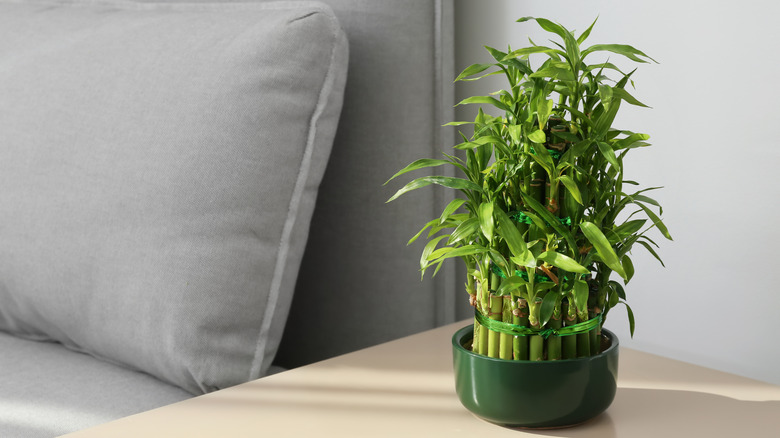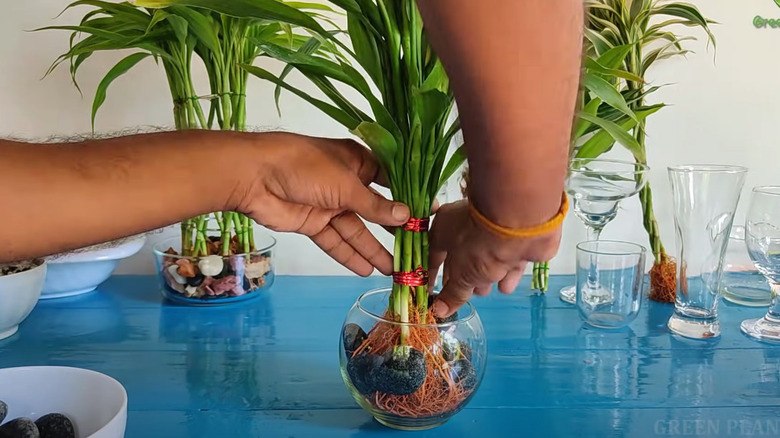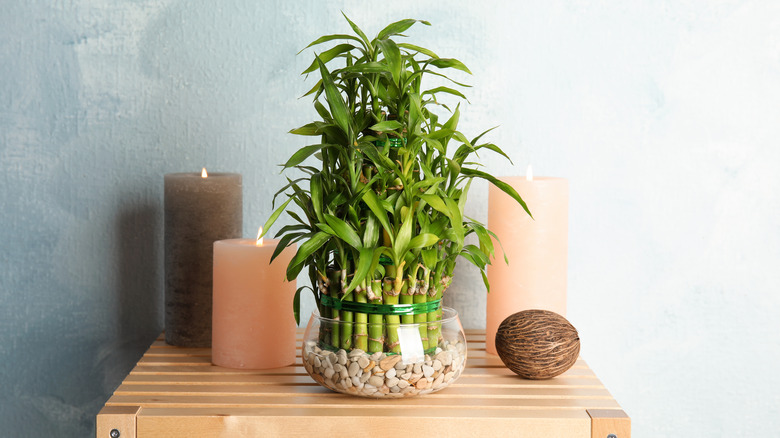Essential Tips For Growing Gorgeous Lucky Bamboo Without Any Soil
Given the rich, lush leaves and an appearance that commands attention, it isn't hard to see why lucky bamboo (Dracaena sanderiana) has become a favorite houseplant. Steeped in Asian culture as a symbol of fortune and resilience for thousands of years, this exotic green found its way into American hearts and homes relatively recently. But the appeal of this plant that's part of the Asparagaceae family isn't just rooted in tradition or its visually-captivating spirals; the real magic lies in its unique ability to thrive splendidly without a granule of soil. Yes, breaking away from traditional dirt-filled pots, lucky bamboo belongs to the unique group of indoor plants that can grow in water, complemented by nothing more than sunlight and a touch of tender care.
However, growing lucky bamboo without soil is more intricate than simply submerging it in a pot of water and hoping for the best. For example, not just any water will do — it's crucial to know exactly what type to use to grow this plant and ensure it thrives. Further, if you don't already own a lucky bamboo stalk, one can be purchased from a nursery or gardening center, where the price will vary with the stalks' height and quantity. For instance, a bunch of 10 4-inch sticks will set you back $10 at Eastern Leaf, a modest price for living green art in your home.
How to grow lucky bamboo in water
Planting lucky bamboo plants in water begins by selecting the Rolls Royce of stalks — those green, vigorous sticks that stand tall and proud, devoid of any hint of distress (think yellowing). If the plants come potted, a gentle liberation of the soil from the roots followed by meticulous cleaning is essential. And here's where the fun begins: why not play nature's artist? Twist pliable sticks into mesmerizing patterns, securing their forms with wires.
When selecting a new home for the lucky bamboo stalks, a clean glass pot fits the bill. Its transparency is not merely for aesthetics (though it'll look stunning), as it also allows you to keep an eye on the roots and the purity of their aquatic environment. Into this vessel, nestle the bamboo sticks, anchoring them with spotless pebbles or gravel. Remember, only the finest water will do — think 2 inches of rainwater, distilled, or filtered. If tap water is your only option, let it stand for a day to allow impurities like chlorine to evaporate. Only the roots should be submerged.
The perfect spot for lucky bamboo mimics their natural hideaway — tucked beneath dense canopies. Find a place in your home where bright, indirect sunlight bathes the plant, far from the harsh midday sun that could scorch the delicate leaves. And a word of caution: the beauty you're nurturing is, paradoxically, a siren to curious furry friends but a perilous one at that. So, place it somewhere safe.
Extra considerations for water-grown lucky bamboo
For diversity, incorporate wine glasses, glass bottles, and jars into the mix. Then, every month, embark on a mini aquatic cleanse by swapping your lucky bamboos' water, thwarting algae invasion and the unwelcome accumulation of salts and minerals. Also, seize the moment to clean the pebbles and pots. In a twist of eco-chic innovation, consider cohabitating your lucky bamboo with nano fish such as celestial pearl danios or pygmy corydoras.
But how about shifting gears from traditional training to phototropism (the plant's intrinsic compass that guides it toward light)? By casting a shadow on lucky bamboo from all sides but one, you'll coax it into a light-seeking bend. A subtle play with light direction will have your bamboo curving into a work of living art.
Leaves losing a bit of their luster is a sign your lucky bamboo plants are in trouble. In this case, they need more light, but tread carefully. Extreme sunlight is a double-edged sword, breeding algae at the roots — a simple trick is to shroud the root section with dark paint or aluminum foil. As for how to make your lucky bamboo grow faster in water, an NPK-balanced, diluted liquid fertilizer every few months will do. And when the bamboo becomes a bit too exuberant for your taste? Snipping off the shoots (not the stalks) should be enough. However, on the off chance that the stalks grow too tall and uninviting, slice them to a desirable size.


